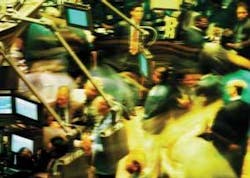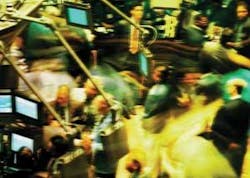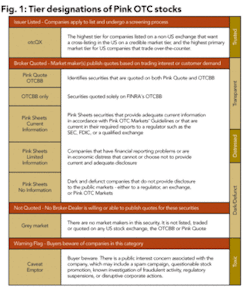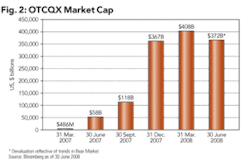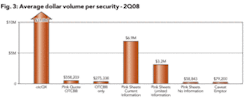New exchange makes it easier to avoid rigors of listing in US
Adam B. Connors, C. K. Cooper & Company, Irvine, Calif.
Frontera Resources, a Houston-based E&P company with focused activities in the country of Georgia, did what many other smaller US companies looking for financing were forced to do in recent years – they went overseas to do an IPO to avoid the high cost of listing in the US and onerous Sarbanes-Oxley reporting. For Frontera, the cost of listing in the US was prohibitive and considered not to be in the best interest of their shareholders, so they decided to list their shares on the AIM market in London. But thanks to a new market in the US called OTCQX (QX) – which offers a less costly disclosure option – Frontera has come back home and has a US listing at a fraction of the cost of a traditional exchange listing on NASDAQ or AMEX/NYSE.
The newly established QX is an elite market tier on the US over-the-counter markets run by Pink OTC Markets in New York. QX is designed to offer investors better investment opportunities than a traditional OTCBB or Pink Sheets listing while providing a more efficient and economical way for microcap and foreign issuers to tap American capital markets.
In post-Sarbanes-Oxley America, it has become very tedious and costly for microcap and foreign issuers to list on a traditional exchange. Many issuers have been driven abroad to exchanges, such as the AIM exchange in London, that offer lower hurdles to being listed. QX is trying to bring some of those issuers home while enticing international companies to reach American investors, as well.
So far, it seems to be working. Frontera listed on QX in February to give US shareholders easier and more efficient access to its shares. Since the shares were previously listed only on a foreign exchange, US shareholders needed to trade Frontera’s securities in British pounds during London trading hours (generally five hours earlier on the US East Coast and eight hours earlier on the West Coast).
Steve Nicandros, Frontera’s president and CEO commented that, “Retail traders and others who are not authorized to purchase AIM stocks for their funds could not take advantage of the opportunities Frontera has to offer.” Nicandros said he felt the AIM market did not fully satisfy the desired exposure to the US markets. After listing on the QX, Frontera immediately began to see increased global trading volume in its stock. The QX listing now accounts for more than 20% of its worldwide volume and its shares are more accessible and palatable to US investors.
Previously, companies wishing to access public markets that did not qualify for an exchange were limited to the OTCBB or Pink Sheets. Companies listed on the Pink Sheets are often disregarded by investors due to the absence of disclosure requirements, and the OTCBB, while requiring SEC registration, does not have a listing process and is seen by some as more risky than traditional investments. The QX helps remove the stigma attached to companies trading OTC by creating a listing process that gives investors more comfort because the listed company must adhere to more investor-friendly standards.
The QX has taken a novel approach to instilling a system of regular and fair disclosure for investors. Instead of the resource draining SEC / Sarbanes-Oxley requirements, QX companies partner with a reputable third party FINRA member investment bank or securities attorney to serve as Dedicated Advisors for Disclosure (DAD). DADs are charged with verifying that companies meet and comply with the QX listing requirements.
When a DAD is engaged by the company, it is charged with verifying that a company has made fair disclosure of its operations, financial condition, etc. It acts as a guide for the issuer to ensure it is fully compliant with QX standards, and then sponsors the company for listing on the service.
According to Tim Ryan, director of OTCQX, the QX “gives great growth companies a visible stage to tell their story and without cash-strapping them before they even get in the door. In the traditional exchange model, the bar is set high enough to ensure that the speculative cannot scale the wall, but it also keeps out some very good companies. By using a sponsorship model with banks that care about their reputations, we are able to permit smaller companies that have a high chance to succeed. Because at the end of the day, our DADs do not want to bring a company to their investors if they think it is a less than investment grade.”
For sponsoring companies, the DAD receives an advisory fee plus the opportunity to expand towards further investment banking and securities law synergies.
For issuers already listed on an exchange abroad, the International QX offers a streamlined listing process that simply requires that the company retain a PAL and provide their home country disclosure on the QX website in English, for easy access by US investors. Some large issuers that have chosen to list on the International QX include Adidas, Wal-Mart de Mexico, Roche, BASF, Marks & Spencer, and Air France.
The International QX provides non-US issuers an efficient and robust platform on which to list securities and access some of the deepest pools of institutional and retail liquidity in the world. By simply providing disclosure consistent with home country reporting requirements in English (to be posted on the QX websites), a foreign company achieves increased visibility in the US marketplace.
By utilizing the SEC Rule 12g3-2(b) exemption, a QX listing protects the company from forced SEC registration until over 50% of its global trading volume takes place in the US. Much like the duties of a DAD for US companies on QX, Principal American Liaisons (PALs) are partnered up with international companies to ensure proper adherence to the QX standards.
For some international companies, utilizing the QX can provide a means of simplification and cost savings. London-based BG Group, a $35 billion large vertical natural gas company, is listed on the London Stock Exchange, had ADRs listed on the NYSE, and was fully SEC reporting. In September, 2007, BG Group delisted from the NYSE and began providing their UK disclosure on OTCQX.
Chris Lloyd, head of investor relations for BG Group explains their decision: “US investors have held between 16% and 23% of our capital (stock) over the last five years. Our move to the OTCQX was to continue to provide a readily accessible platform following our deregistration and delisting. The decision to deregister was driven by a view that complying with the SEC rules had become unduly burdensome and expensive.”
Janelle van de Velde, manager of investor relations and corporate communications for Linc Energy, an Australian-based alternative energy company that focuses on clean coal and is dual listed on the ASX and QX noted, “We believe that the QX listing provides us with greater leverage in the United States in particular; however, more broadly, we now have an avenue by which people can trade in our stock overseas without the arduous compliance of Sarbanes-Oxley. Our US investor base has expanded and we have increased international liquidity.”
According to van de Velde, Linc Energy was “seeking to broaden their overseas shareholder base and increase liquidity, thereby maximizing value to all shareholders.”
Financially, the QX can prove very appealing vs. the full SEC / SOX alternative. On average, companies can expect to save about $500,000 per year being QX listed.
Jaclyn Inc., in the fashion manufacturing industry, delisted from the AMEX and listed on the QX. In a company press release, the company said it “anticipates savings of approximately $500,000 on an annual basis as a result of the proposed deregistration and delisting…” On average, a fully SEC reporting / SOX compliant microcap company can expect an annual cost anywhere from $750,000 to $1,000,000. In contrast, a US company with a primary listing on QX can expect to spend around $250,000 a year while an international company with a non-US exchange listing can spend less than $65,000.
Wall Street is starting to adopt the QX as well. Bloomberg and Reuters have all started distinguishing QX vs. Pink Sheets and OTCBB securities and roughly $1 billion in volume is traded in QX securities each month. On average, a QX company trades over 70 times more by volume than the average OTCBB company.
In C. K. Cooper’s view, the QX is particularly suited to the global oil and gas industry. Oil and gas E&P companies often require significant upfront capital expenditures, but capitalization requirements of other exchanges often prevent them companies from qualifying, therefore limiting their access to capital. Additionally, formidable compliance procedures required by the SEC can be a drain on the limited time and resources of the emerging E&P’s small management teams and resources. The QX addresses these problems by offering multiple tiers, so the company can transition to the higher tier exchange as it is able to satisfy the stricter requirements. The objective of this model is to provide smaller companies avenues to raising capital, while satisfying investor demand for disclosure.
By taking into consideration the requirements of the approved international exchanges and applying the QX listing standards, investors have a higher degree of confidence than a company that is simply broker-quoted on the Pink Sheets. To illustrate further, Frontera’s Steve Nicandros explains, “If the company is attached to a strong overseas exchange, it is a wonderful way for US investors to capture that credibility in the stock and find some real bargains.”
Additionally, one of the most distinct and investor friendly aspects of the QX is the qualitative review aspect of the application to trade on the QX. The QX, during the application process, reviews management, business operations, and other aspects to affirm an actual, legitimate company, with a reputable management team.
Assuming the company meets the requirements plus nominates a DAD or PAL advisor, the company can be listed and trading on the QX within about three months. Additionally, QX can provide a better launching pad for a future exchange listing on NYSE or NASDAQ if that is the desired goal.
One of the hurdles of the QX as an organization has been its association with the Pink Sheets – an organization which has traditionally carried negative cogitations as the domain of lackluster disclosure and penny stocks. The QX, with more stringent listing requirements, both quantitative and qualitative, coupled with its requirement to partner with a DAD/PAL, is beginning to shift those views.
Listing requirements (primary listing)
For US companies and international companies not listed elsewhere, the OTCQX listing process is more strenuous since it is considered a company’s primary listing. To list, US companies must meet the requirements shown in Table 1.
In addition, each tier must:
- Have ongoing operations (no shells, blank check or special purpose acquisition companies);
- not be subject to any bankruptcy or reorganization proceedings;
- be duly organized, validly existing and in good standing under the laws of each jurisdiction in which the company is organized;have proprietary quotations published on Pink Quote;
- have ongoing quarterly and annual financial reports posted on OTCQX.com or EDGAR for SEC Registered companies. Annual reports should be audited and prepared in accordance with US GAAP;
- be included in the Standard & Poor’s Corporation Records or Mergent Manuals (aka Moody’s Manuals), which satisfies the Blue Sky requirements for secondary transactions in many states, together with a list of any other states in which the security is Blue Sky compliant and eligible to be sold by brokers in those states;
- obtain a DAD Letter upon application and annually thereafter to Pink OTC Markets Inc. confirming that the issuer has made adequate current information publicly available and meets the tier inclusion requirements.
Listing requirements (international cross-listing)
For international companies listed on a qualified exchange, the OTCQX International is a favorable option. The OTCQX International is divided into two tiers as well: the International PremierQX and the International PrimeQX. The qualifications and distinctions for these two tiers are shown in Table 3.
In addition, each international tier must:
- Be listed on a Qualifying Foreign Stock Exchange (see Table 1);
- appoint a Principal American Liaison (PAL);
- be current in 12g3-2b obligations and information posted in English on the OTC Disclosure and News Service - so investors have access to credible disclosure;
- have proprietary quotations published by a Market Maker in Pink Quote - to provide a ready market for US investors in a visible trading venue;
- be included in the S&P or Mergent Manual for Blue Sky compliance.
As noted previously, the QX is run by Pink OTC Markets – formally the Pink Sheets –traditionally a carrier of negative cogitations. However, one should consider the developments Pink OTC Markets have made in recent years. They are the backbone of the electronic OTC market where large market-making firms, including Knight, Citi, UBS, E-trade, and 200 other firms actively trade QX and Pink Sheets stocks. In fact, dollar volume on Pink Sheets stocks has increased by 300% in the last three years and is five times greater than the OTCBB market. With QX, which creates the first-ever listing process to distinguish reputable companies, and increased transparency indicators for Pink Sheets stocks, Pink OTC is dramatically improving the transparency and efficiency of OTC trading.
As an example of these changes, Pink OTC categorizes all OTC stocks (see Fig. 1).
With the world continuing to become smaller while the world’s energy demand becomes larger, many oil and gas companies are continually finding opportunities in emerging markets. These companies are able to carve out and create valuable niches. However, their primary exchange may not have the capacity to meet their capital needs.
For oil and gas companies listing in the US, the QX is a viable alternative that allows companies to focus on their business model first and being public second. The QX offers a way to couple greater transparency and legitimacy without the large burden of being fully SEC reporting. OGFJ
About the author
Adam B. Connors is the director of corporate finance at C. K. Cooper & Company, a full-service boutique investment bank that focuses on the energy industry. Connors directs the OTCQX Designated Advisor for Disclosure (DAD) and Principal American Liaison (PAL) activities at C. K. Cooper.
